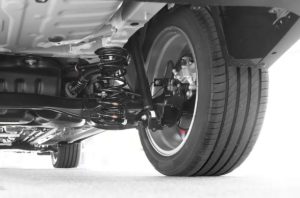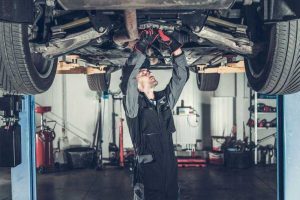Your vehicle’s suspension system is more than just a comfort feature — it plays a vital role in safety. From crash impact absorption to stability control, suspension components like springs, dampers, struts, and anti-roll bars greatly affect how a vehicle behaves in emergencies. In this article, we’ll explain how suspension design influences crash performance, stability systems, and overall driver safety.
Crash Impact: How Suspension Protects You

During a collision or sudden stop, the suspension system absorbs and dissipates tremendous amounts of energy. Here’s how:
-
Initial energy absorption: Springs compress to take up some of the kinetic energy.
-
Damping: Shock absorbers reduce oscillation, converting motion into heat.
-
Geometry control: Properly aligned suspension maintains tire contact with the road for braking and steering.
Effect of Suspension Stiffness on Crash Safety
| Feature | Soft Suspension | Stiff Suspension |
|---|---|---|
| Impact Absorption | High — more bounce, body dynamics | Low — sharper impact but may transmit force |
| Braking Performance | Variable — tires may lift from road | More consistent weight transfer |
| Rider Protection | Better initial cushioning | Less cushioning but greater firmness |
| Body Control | Increased pitch and dive tendencies | More stable under heavy braking |
Key Insight: Suspension tuning must strike a balance. Too soft, and the body dives too much; too hard, and crash forces may transmit directly to occupants.
Role in Electronic Stability Control (ESC)
Modern vehicles rely heavily on ESC systems (also known as ESP or VSC). These systems modulate brake pressure and engine output to prevent skidding or rollover. Suspension plays a critical support role:
-
Maintains tire contact: Suspension must keep all tires firmly on the ground for traction.
-
Controls body roll: Anti-roll bars and damping help ESC systems correctly judge and apply corrective braking.
-
Sensing dynamics: ESC sensors interpret yaw, pitch, and roll — data that suspension geometry affects.
Roll Resistance and Stabilizer Bars
Anti-roll bars (stabilizer bars) are essential for keeping body roll in check during corners or sudden maneuvers:
-
Connect left and right wheels to resist tilt.
-
Work together with ESC to reduce oversteer or understeer.
Front vs. Rear Bar Role (in Stability)
| Axis | Front Bar Effect | Rear Bar Effect |
|---|---|---|
| Cornering roll | Reduces nose dip, improves turn-in | Reduces tail roll, balances grip |
| Oversteer/Understeer | Stiffer bar → more understeer | Stiffer bar → more oversteer |
| ESC calibration | Adjusts front braking reactions | Works with rear for balance |
Proper tuning — including adjustable bars — helps ESC systems steer effectively during skids.
Suspension Geometry and Crash Path
Suspension alignment and geometry ensure vehicles stay predictable and controllable. Here’s how:
-
Toe and Camber
-
Affects tire grip during cornering, braking, and impact.
-
Helps maintain contact during hard stops or evasive action.
-
-
Caster
-
Affects steering feel and return-to-center behavior—critical during high-speed maneuvers.
-
-
Ride Height
-
Too low: risk of bottoming out, altered force transfer.
-
Too high: increased rollover risk, heightens center of gravity.
-
Stability Tip: After suspension repair or modification, realignment is essential to preserve crash performance and tuning.
Importance of Suspension Upgrades for Safety
If your suspension components — springs, dampers, struts, bushings, or bars — are worn, here’s what can happen:
-
Delayed braking response, increasing stopping distance.
-
Excessive body roll, destabilizing handling in sudden maneuvers.
-
Unequal tire contact, reducing grip in wet or icy conditions.
-
Reduced ESC effectiveness, increasing rollover or spin risk.
When to Consider Suspension Upgrades or Replacement
-
Mileage over 80,000 km or suspension feels loose.
-
Drivers find increased body roll or nose dive during braking.
-
Tire wear is uneven across the tread.
-
You’ve modified ride height (lowered or lifted) without suitable parts.
Upgrading Suspension Safely

When upgrading suspension, keep these tips in mind:
-
Choose quality OEM or performance parts matching your vehicle’s specs.
-
Match springs and dampers — they must work as a coordinated system.
-
Install anti-roll bars appropriate for driving style (e.g., softer for comfort, stiffer for sport).
-
Re-align after installation to reset geometry precisely.
-
Retune ESC if you make major changes; in some vehicles, recalibration is necessary.
Boost Your Safety with a Proper Suspension
A well-maintained suspension keeps you safer by:
-
Ensuring short, reliable braking distances.
-
Maintaining stability in sharp turns or evasive maneuvers.
-
Improving steering response and predictability.
If you’re repairing or upgrading shocks, struts, springs, or anti-roll bars, only fit components engineered to optimize safety and performance.
Where to Get Quality Suspension Parts
Looking to replace or upgrade your rear suspension components?
This store offers a wide selection of springs, struts, shocks, anti-roll bars, and complete suspension kits — all tailored to your vehicle model and safety requirements. Find exactly what you need for improved crash handling and stability.
Final Thoughts
A vehicle’s suspension is more than comfort gear — it’s a critical safety system. From absorbing crash forces to ensuring ESC systems work correctly, every component influences how your car behaves when it matters.
Keep components fresh, aligned, and tuned to your driving style — your safety depends on it.
Drive safe, drive smart — your suspension has your back.